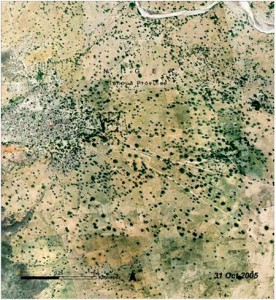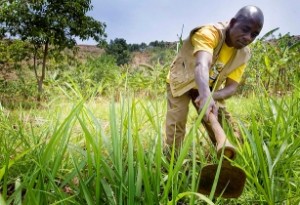 Integrating trees, crops and livestock into farming systems translates to drought resilient, productive and sustainable systems. This innovation has drawn the attention of farmers, cultivating new trees in their farms for the purpose of providing fodder, fuel, food as well as other domestic needs. With ample training on these technologies and support from relevant institutions, farmers’ dependency on rangelands and frustrations on low productivity levels reduces as experienced in diverse African nations.
Integrating trees, crops and livestock into farming systems translates to drought resilient, productive and sustainable systems. This innovation has drawn the attention of farmers, cultivating new trees in their farms for the purpose of providing fodder, fuel, food as well as other domestic needs. With ample training on these technologies and support from relevant institutions, farmers’ dependency on rangelands and frustrations on low productivity levels reduces as experienced in diverse African nations.
Monthly Archives: November 2015
African farmers turn to climate-smart agriculture
El Nino causing drought across Sahel: EverGreen Agriculture resources to fight back
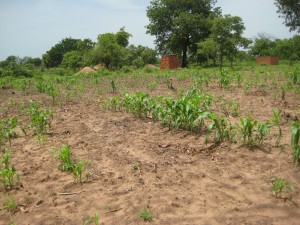 According to Climate Central, the highly erratic El Niño effect on weather patterns has affected rainfall across the Sahel and West Africa during 2015. The Hadley Centre of the UK Meteorological Office predicted a stronger El Niño effect this spring than 2014’s partial failure of the rainy season that reduced harvests for up to 400,000 people. The Famine Early Warning Systems Network revised analysis in August showed that, indeed the rains started late in many regions, delaying planting of peanuts, millet, and sorghum in northwestern Senegal, southwestern Mauritania, areas in central and eastern Niger, northeastern Nigeria, and Chad. Once rains began some areas experienced flooding leading to loss of early plantings.
According to Climate Central, the highly erratic El Niño effect on weather patterns has affected rainfall across the Sahel and West Africa during 2015. The Hadley Centre of the UK Meteorological Office predicted a stronger El Niño effect this spring than 2014’s partial failure of the rainy season that reduced harvests for up to 400,000 people. The Famine Early Warning Systems Network revised analysis in August showed that, indeed the rains started late in many regions, delaying planting of peanuts, millet, and sorghum in northwestern Senegal, southwestern Mauritania, areas in central and eastern Niger, northeastern Nigeria, and Chad. Once rains began some areas experienced flooding leading to loss of early plantings.
Highly unpredictable rainy seasons, combined with long-term regional drying and land degradation, require innovative resilience strategies. Dependence on traditional annual cereals, yams, and fodder crops leaves far too many families food insecure. Fortunately, there are many resources across the Sahel for perennial and annual crops that are more resilient to drought and flooding. Two organizations providing seeds, seedlings, and trainings for agroforestry and conservation agriculture are ECHO and ICRISAT. The ECHO West Africa Impact Center was opened in Ouagadougou, Burkina Faso in 2014 to compliment its East Africa Impact Center in Arusha, Tanzania. The International Crops Research Institute for the Semi-Arid Tropics has centers in Mali, Niger, and Nigeria.
New research on gender in Agroforestry

The International Forestry Review has recently published a collection of papers on gender in Agroforestry. These papers provide insight into the roles, benefits and perceptions of both men and women in Agroforestry. We consider some of these insights and emerging lessons for Evergreen Agriculture.
The full issue includes studies from Asia, Africa and South America and highlights the great diversity in the roles men and women play in agroforestry between regions, countries and ethnic groups. Gendered roles and responsibilities impact who can plant what variety of tree and where, who cares for these trees and who benefits from which specific parts of the tree. For example women in Africa generally have rights over indigenous fruits such as shea, while men almost universally own tree commodities such as timber.
These varying gender roles and responsibilities can influence both the practice of Agroforestry and dictate who benefits from it. For this reason, gender should be considered in Evergreen Agriculture activities. Some lessons for Evergreen Agriculture from these recent studies include:
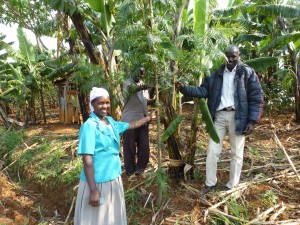 • It is important to understand the roles and responsibilities men and women have in terms of tree planting, management and harvesting in project areas.
• It is important to understand the roles and responsibilities men and women have in terms of tree planting, management and harvesting in project areas.
Men and women are likely to prefer different tree species based on the control they have over the products coming from the species. Targeting training and provision of species on to men and women based on their priorities is likely to increase adoption.
• When providing training consider the accessibility and appropriateness of the materials for both men and women.
There are many more gender lessons for Evergreen Agriculture in the full issue and other readily available resources. By considering gender in your activities you could greatly improve tree planting and a more equitable sharing of the benefits.
Realizing the vision of forests – how Evergreen Agriculture can contribute
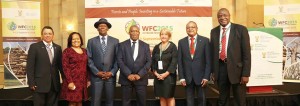 The importance of forests in supporting the achievement of the new Sustainable Development Goals was a key outcome of the recent XIV World Forestry Congress held in South Africa, but how does EverGreen Agriculture fit into this vision?
The importance of forests in supporting the achievement of the new Sustainable Development Goals was a key outcome of the recent XIV World Forestry Congress held in South Africa, but how does EverGreen Agriculture fit into this vision?
Key messages emerging from the Congress highlight the universally agreed upon services forests provide. For the rural poor, forests are an important source for food, wood energy, shelter, fibre and livelihoods. For the environment, they play a huge role in mitigating climate change, protecting soils and water and harbouring the world’s biodiversity.
While there remains great concern about the rate of deforestation and pressures facing forest resources, it’s encouraging to see some positive news emerging. Coinciding with the congress was the release of the Global Forest Resources Assessment by FAO, indicating that over the past 25 years the rate of net global deforestation has slowed down by more than 50%. The report noted, that the reduction in the rate of decline is largely attributed to increases in the area of forests under protection and improved forest management through policy changes and greater engagement of local communities in decision-making.
The intention to continue the good news for global forests is strongly evident in the Durban Declaration for a 2050 vision for forests and forestry, which was delivered as an outcome of the Congress. A key feature of the declaration is the need for inter-sectorial coordination and collaboration to achieve the vision for sustainably managed forests. This is highlighted through the need for an integrated landscape scale approach, which addresses the drivers of deforestation and capitalizes on the triple bottom line benefits of integrating forests with agriculture.
Evergreen Agriculture should be considered as a major opportunity to improve the agriculture-forestry linkages in the landscape in order to support the global vision for sustainably managed forests.
An integrated approach through the intercropping of trees with food crops and livestock through EverGreen Agriculture can contribute to reducing the primary causes of deforestation. This has been seen through improvements to smallholder food security and livelihoods through providing forest-based resources on farm, such as fuel wood, whilst improving farm productivity through improved soil health. Additionally, the inclusion of more trees in the landscape and connectivity to forests can enhance the resilience of existing forest resources and the environmental services they provide.
The question therefore remains, how do we foster greater inter-sectorial coordination and collaboration within the forestry sector to accelerate the adoption of EverGreen Agriculture to realize our global vision for forests?
The XIV World Forestry Congress was held between the 7-11 September, 2015 at the Inkosi Albert Luthuli International Convention Centre in Durban. A full summary of the Congress proceedings and events, which was attended by nearly 4,000 participants from 142 countries, are available on the World Forestry Congress website
Agroforestry and fertilizer trees improve crop yields
“Evergreen Agriculture systems replenish soil fertility, provide food, fodder, timber and fuelwood, translating to greater value than that of the annual crop within the area that they occupy,” notes Dennis Garrity. The inclusion of trees in cultivated landscapes results in an average value of $1.40/year and increased dietary diversity among children in African countries.
Development Investors called to use Evergreen Agriculture in poverty alleviation programs
 Following the release of their significant report “Scaling Up Regreening: Six Steps to Success, A Practical Approach to Forest and Landscape Restoration” Chris Reij and Robert Winterbottom, of WRI and founding members of the EverGreen Agriculture Partnership, have called upon investors in the development sector, such as the Gates Foundation, to give more consideration to the proven potential of regreening to support food security and rural development in many parts of the world.
Following the release of their significant report “Scaling Up Regreening: Six Steps to Success, A Practical Approach to Forest and Landscape Restoration” Chris Reij and Robert Winterbottom, of WRI and founding members of the EverGreen Agriculture Partnership, have called upon investors in the development sector, such as the Gates Foundation, to give more consideration to the proven potential of regreening to support food security and rural development in many parts of the world.
In a recent interview with David Brown, published by the Mongabay Reporting Network, Reij and Winterbottom explain the potential of regreening further, and what is needed to scale it up. Read here for the full story.


